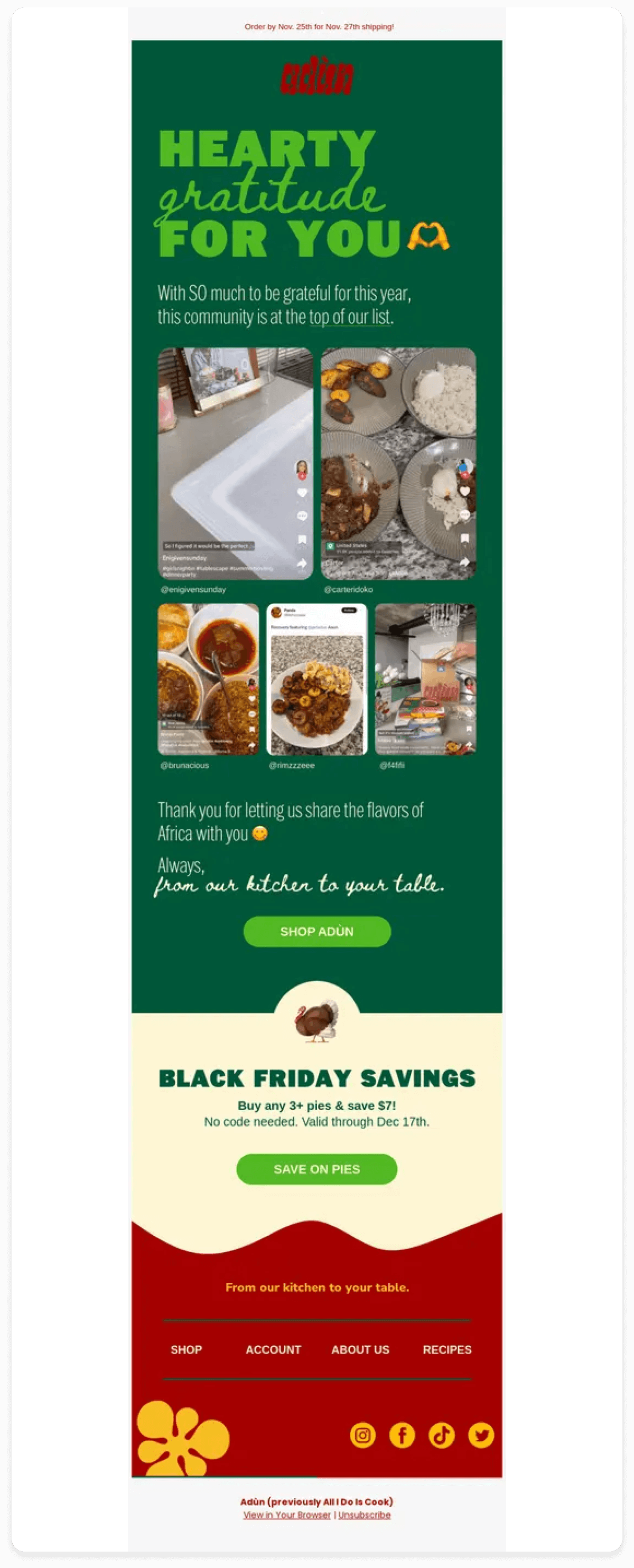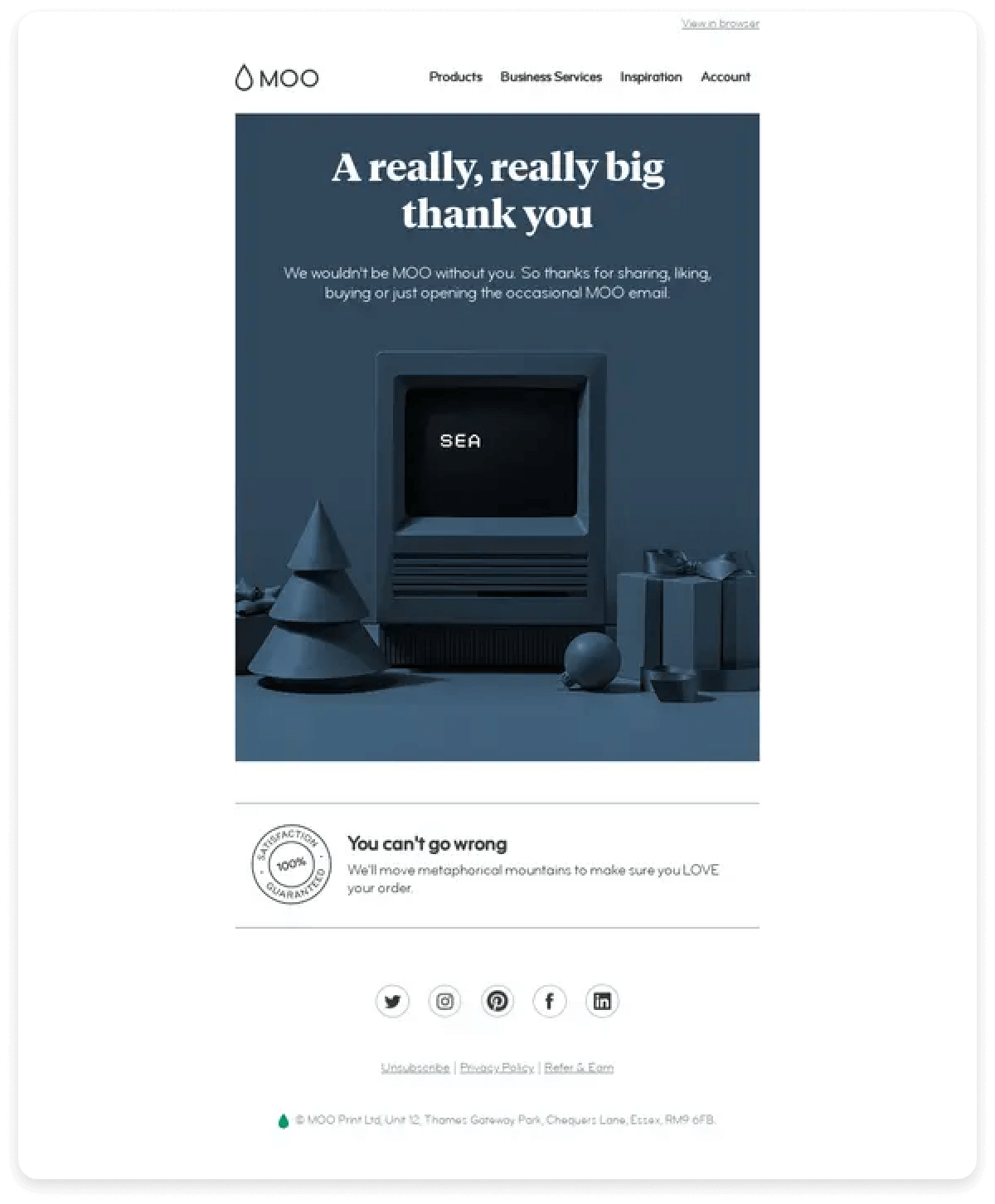Types of thank you emails
Thank-you emails are essential for building and maintaining relationships in business. Here are several key types to consider:
1. Corporate thank you emails
These emails are directed to team members following the successful completion of a project. They highlight individual contributions and express gratitude for collective efforts. Additionally, team members can send thank-you notes to management after receiving promotions or bonuses, as positive feedback.
2. Customer thank you emails
These can be sent after a purchase, service engagement, or even an inquiry about your business. Thanking customers not only acknowledges their support but also encourages them to become repeat clients. A well-crafted thank-you can leave a lasting positive impression.
3. Partner thank you emails
Expressing gratitude to business partners is crucial for nurturing long-term relationships. Acknowledging their contributions and commitment to quality service reinforces collaboration and stability, which are vital for business success.
4. Colleague thank you emails
Within a team, it’s important to recognize the contributions of colleagues, even if you interact regularly. Sending a thank-you email can boost morale and foster a sense of belonging. This could be directed to team members, supervisors, or department heads, acknowledging their specific achievements and support.
5. Thank you for feedback
After meetings, presentations, or interviews, it’s important to thank attendees for their time and insights. This email emphasizes the value of their presence and contributions. Sending a thank-you note after a job interview, regardless of the outcome, demonstrates professionalism and respect for the opportunity.

6. Response to job enquiries
When responding to job applications where no vacancies exist, it’s courteous to thank candidates for their interest. This not only reflects well on your company name but also keeps the door open for potential future opportunities.
7. Gratitude for mentorship or previous employment
Sending thank-you emails to former supervisors or mentors shows appreciation for the guidance and experience gained. This gesture can strengthen professional networks and may lead to future opportunities.
8. Post-event thank you emails
After attending or hosting an event, sending thank-you emails to participants, speakers, or organizers acknowledges their efforts and fosters connections for future collaborations.

How to create effective thank you emails
When crafting a thank-you email, it’s essential to ensure that the recipient feels the message is specifically addressed to them. Here are some things that you should consider when crafting a thank you email.
1. Length and structure
Always aim for three concise paragraphs. This length helps maintain clarity and keeps the recipient engaged. Longer emails can confuse or bore the reader, diminishing the impact of your gratitude.
2. Personalization
Make an effort to personalize your message. Use the client name and reference specific details related to your interaction. This shows that you value them as an individual.
3. Clarity of purpose
Ensure your message is clear and direct. Avoid unnecessary jargon or complicated language that might detract from your main point. The recipient should understand your gratitude without having to decipher the message.
4. Engaging subject line
Craft a subject line that captures attention and indicates the email’s purpose. Including the recipient's name in the subject can enhance its personal touch and encourage them to open it.
The primary line of the letter is the subject, which determines whether the recipient will read the content or not. Therefore, do not try to experiment with the presentation of the topic, let it be simple and concise.
5. Appropriate greeting
Begin with a friendly greeting and warm regards that match the context of your relationship. For formal emails, use “Dear [Name]” or “Good afternoon.” In more casual contexts, “Hi [Name]” or “Hello!” is suitable.
6. Expression of genuine gratitude
Clearly articulate what you are thankful for, using a sincere and professional tone. Mention specific actions or contributions that prompted your appreciation to make your message more impactful.
7. Conciseness
After writing your email, review it from the recipient's perspective. Remove any extraneous details that may distract from your main message. Leave only what you, as a customer, would like to hear on a positive note.
8. Readability
Use a clean, readable font and format your email for mobile devices, as many people check their emails on smartphones. Highlight important points with bold or italics to draw attention without overwhelming the reader.
9. Professional email signature
For corporate emails, include an official electronic signature. For more casual messages, simply sign with your name. An identifiable signature adds credibility and helps the recipient trust your message. But the signature must be mandatory, anonymous appeals are, at the very least, disreputable, and at the most, they will cause mistrust in the addressee.
If you want to encourage further communication, provide your contact details at the end of the email such as phone number and address. This shows your willingness to engage and continue the relationship for future communications.
11. Proofread
Before sending, carefully proofread your email for spelling, grammar, and formatting errors. A polished message reflects your professionalism and respect for the recipient. Allow the addressee to believe that you treated this letter seriously and responsibly.
The importance of thank you emails for recipients
Sending a thank-you email is more than just a courteous gesture; it is a vital tool for building and nurturing professional relationships. By expressing gratitude, you establish a positive connection with your recipients, who may include:
- Current clients: Reinforcing appreciation can enhance loyalty and encourage repeat business.
- Potential clients: A thoughtful thank-you can leave a lasting impression, increasing the likelihood of conversion.
- Business partners: Acknowledging their contributions fosters collaboration and strengthens partnerships.
- Colleagues: Expressing gratitude among team members cultivates a supportive work environment and boosts morale.
Each of these groups plays a significant role in the success and growth of your business. By actively maintaining and expanding your client base, you signal your strength to partners and stakeholders. Collaborative successes, rooted in mutual respect and appreciation, lead to both moral and financial satisfaction for everyone involved.
As you can see, something as small as a thank you email is a key link in building relationships with your target audience and an opportunity to strengthen them. Therefore, do not neglect the opportunity to use a thank you letter for your customers.
The value of sending thank you emails from employees
Thank-you emails are not just for company executives; employees can also harness the power of gratitude to enhance their professional relationships and increase their visibility within the organization. Here are several compelling reasons why sending thank-you emails can be beneficial:
- Demonstrating gratitude: By thanking your manager for their support or recognition, you express appreciation and reinforce your commitment to contribute even more to the team’s success.
- Acknowledging contributions: When you thank the organizer of a workshop, meeting, or presentation, you validate their efforts and signal that their work had a positive impact. This fosters a culture of appreciation and collaboration.
- Upholding professional etiquette: A thank-you note for being recognized shows professionalism and humility. Acknowledging someone’s appreciation of your work reflects positively on your character and work ethic.
Sending a thank-you email requires just a sincere desire to express gratitude and a small investment of your time. The rewards of this gesture can be significant, as people generally respond well to genuine appreciation.
Final takeaway
In conclusion, thank-you emails are a powerful tool for fostering meaningful connections with your recipients. They not only help retain existing customers and stimulate sales but also encourage former clients to re-engage with your business. By making recipients feel valued and appreciated, you increase their willingness to interact and collaborate with you for future events.
By following the recommendations outlined in this article, you can craft professional and impactful thank-you emails that resonate with your audience. Embrace the art of gratitude, and watch as it enhances your relationships and drives positive outcomes for your business!






















